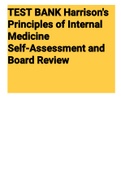Exam (elaborations)
TEST BANK Harrison's Principles of Internal Medicine Self-Assessment and Board Review
- Course
- Institution
TEST BANK Harrison's Principles of Internal Medicine Self-Assessment and Board Review SECTION I General Considerations in Clinical Medicine QUESTIONS DIRECTIONS: Choose the one best response to each question. I-1. All of the following statements regarding practice guidelines set forth by governing ...
[Show more]



